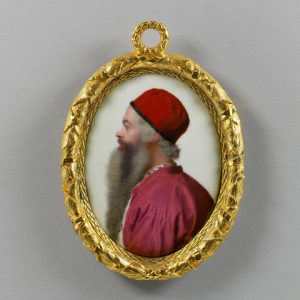26. Choice 16: Tonton’s Snuff-Box
by Wilmarth S. Lewis
“Walpole escaped to Paris in November 1765, after the most mortifying disappointment of his life, the failure of his friends, especially of Conway, to offer him a place in the first Rockingham Ministry which he had helped to form. He would not have accepted a place, but his pride would have been satisfied by refusing it. ‘Falsehood, interest, and ingratitude, the attendants of friendship, are familiar to me,’ he wrote Mann bitterly; but no Englishman ever went to Paris with more friendly letters of introduction to its great world or enjoyed more of a success when he got there. He wrote Gray, ‘Like Queen Eleanor in the Ballad, I sunk at Charing Cross, and have risen in the Faubourg Saint Germain‘ where he was drawn speedily into Madame du Deffand’s circle. She, whom he described to Conway as ‘an old blind débauchée of wit,’ ![Duchesse de Choisel, and Madame la Marquise Du Deffand [graphic] : (from the original formerly at Strawberry Hill) / M. Carmontel, del. ; W. Greatbach sculp.](https://campuspress.yale.edu/walpole300/files/2018/07/Mme-du-deffand-29lufgd-199x300.jpg) became infatuated with him although twenty years his senior. Forty years earlier she had been a mistress of the Regent Orléans and that gave her a certain panache even though the connection had lasted only two weeks. To her Walpole was a radiant newcomer who exorcised the devil ennui that possessed her. Before long they were meeting daily. His delight in her company and his pride in having made a Platonic conquest of the wittiest woman in Paris fused with his indignation at the ‘barbarity and injustice’ of those who ate her suppers when they could not go to a more fashionable house, who laughed at her, abused her, and tried to convert her nominal friends into enemies in what she called their ‘société infernale.’
became infatuated with him although twenty years his senior. Forty years earlier she had been a mistress of the Regent Orléans and that gave her a certain panache even though the connection had lasted only two weeks. To her Walpole was a radiant newcomer who exorcised the devil ennui that possessed her. Before long they were meeting daily. His delight in her company and his pride in having made a Platonic conquest of the wittiest woman in Paris fused with his indignation at the ‘barbarity and injustice’ of those who ate her suppers when they could not go to a more fashionable house, who laughed at her, abused her, and tried to convert her nominal friends into enemies in what she called their ‘société infernale.’
Lewis then describes the journal Walpole kept of his five visits to Paris from 1765 to 1775, now at Harvard, cites typical entries, quotes from “the final entry in Mme du Deffand’s last journal, which she left Walpole and which is now at Farmington,” and recounts the episode of the pretend letter that Walpole sent to Rousseau supposedly from the King of Prussia which ended up destroying the friendship between Rousseau and Hume.
“When Walpole returned to England in 1766 he and Mme du Deffand began the correspondence which went on until she died fourteen years later, some 850 very long letters on each side. Walpole got her to return his letters and presumably directed Mary Berry, his literary executrix to make extracts from them as footnotes to a posthumous edition of Mme du Deffand’s letters to him, after which Miss Berry was to destroy his side of the correspondence. . . .He made four laborious trips to see and entertain her and to bring her what comfort and pleasure he could until war was declared between France and England. When her income was cut he offered to make up the loss from his own pocket, but she would not let him do it. 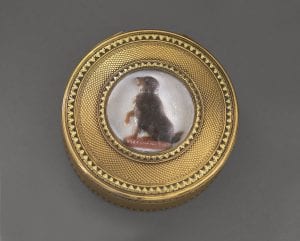 Although she wanted to leave him all she had, he accepted only her manuscripts and her little black spaniel, Tonton, who was not house-broken and who bit people. She included the gold snuff-box made by the king’s jeweller with Tonton’s portrait in wax by Gosset that a friend gave her as a New Year’s present in 1778. The Chevalier Boufflers wrote verses on Voltaire and Tonton that Mme du Deffand sent to Walpole.
Although she wanted to leave him all she had, he accepted only her manuscripts and her little black spaniel, Tonton, who was not house-broken and who bit people. She included the gold snuff-box made by the king’s jeweller with Tonton’s portrait in wax by Gosset that a friend gave her as a New Year’s present in 1778. The Chevalier Boufflers wrote verses on Voltaire and Tonton that Mme du Deffand sent to Walpole.
“Vous les trouvez tous deux charmants,
Nous les trouvons tous deux mordants;
Voilà la ressemblance:
L’un ne mord qu ses ennemis,
Et l’autre mord tous vos amis,
Voilà la différence.
“The manuscripts were kept in a cedar chest in the library at Strawberry until sold in 1842 to Thorpe the bookseller for £156.10s. Sir Frederick Madden of the British Museum recorded that ‘directly after the conclusion of the sale the chest was purchased by Dyce-Sombre who came down in a carriage and four accompanied by his wife, and the latter taking a fancy to these letters her wealthy husband gave Thorpe 20 guineas additional for them and carried them off.’ The lady bequeathed them to her nephew, W.R. Parker-Jervis of Staffordshire, They were resold through Sotheby’s in 1920, just four years before I began collecting Walpole. Paget Toynbee bought Mme du Deffand’s letters to Walpole for £20 and gave them to the Bodleian; Seymour de Ricci bought her letters to Voltaire and gave them to the Bibliothèque Nationale. Most of the rest went to Maggs, who in December 1933 let me have them for £50 to make me, as they said, ‘A Christmas present.’ In 1938 they retrieved for me the most interesting book in the collection, which had been bought by another dealer in 1920. This was Mme du Deffand’s “Recueil de divers ouvrages,’ over 270 pages, 4to, with 45 ‘portraits’ of her friends magnificently bound in red morocco. Walpole wrote inside the front cover 

that the book had been bequeathed to him by Mme du Deffand with her other manuscripts and he pasted in seven and a half pages of notes that included his ‘portrait’ of her, which is in English.
“Portrait de Madame la Marquise du Deffand, 1766,
Where do Wit and Memory dwell?
Where is Fancy’s favourite cell?
Where does Judgment hold her court,
“and continues for 27 lines of conventional compliment until the close:
“Together all these Virtues dwell:
St Joseph’s convent is her cell:
Their sanctuary Du Deffand’s mind–
Censure, be dumb! She’s old and blind.
“Far from being wounded by the last line Mme du Deffand was flattered because it proved, she said, the sincerity of what went before.
“Her ‘Portrait’ of Walpole, which he asked her to write, is the most important summary of him ever written. This translation of it is by Catherine Jestin, Librarian of the Lewis Walpole Library.
“‘No, no, I cannot do your portrait. No one knows you less than I do. You appear sometimes as I wish you were, sometimes as I fear you may not be, and perhaps never as you really are. It is obvious you are very intelligent in many ways. Everyone knows this as well as I, and you should be aware of it more than anyone.
“‘It is your character that should be portrayed, and that is why I cannot be a good judge: indifference, or at least impartiality, is essential. Yet I can vouch for your integrity. You are pincipled and courageous and pride yourself on firmness of purpose, so that when you make a decision, for better or worse, nothing can make you change your mind, often to the point of obstancy. Your friendship is warm and steadfast, but neither tender nor yielding. Fear of weakness hardens you; you try not to be ruled by emotions: you cannot refuse friends in dire need, you sacrifice your interests to theirs, but you deny them smallest favours; you are kind to everyone, and to those to whom you are indifferent, yet for your friends, even where trifles are concerned, you hardly bother to exert yourself.
“‘Your disposition is very pleasing although not too equable. Your manner is noble, easy and natural; your desire to please is without affectation. Knowledge and experience of the world have made you scorn humanity and yet you have learned to adjust; you know that outward expressions are merely insincerities; you respond with deference and good manners so that all those who do not care in the least whether you like them or not have a good opinion of you.
“‘I do not know if you have much feeling; if you do, you fight it, for you think it a weakness; you allow yourself only the loftier kind. You are thoughtful, you have absolutely no vanity although plenty of self-esteem, but your self-esteem does not blind you: it leads you to exaggerate your faults rather than to hide them. You give a good opinion of yourself only if forced to do so when comparing yourself with others. You have discernment and tact, perfect taste and faultless manners. You would have been part of the most fashionable society in centuries past; you are so now in this, and would be in those of the future. Your character derives much from your country, but your manners are equally correct everywhere.
“‘You have one weakness which is inexcusable: fear of ridicule. You sacrifice your better feelings to it and let it regulate your conduct. It makes you harken to fools who give you false impressions that your friends cannot rectify. You are too easily influenced, a tendency you recognize and which you remedy to adhering too strictly to principle; your determination never to give in is occasionally excessive, and at times when it is hardly worth the effort.
“‘You are noble and generous, you do good for the pleasure of doing so, without ostentation, without hope of reward: in short your soul is beautiful and good.
“‘Addition to the Portrait, 30 November 1766.
“‘Only truth and simplicty please you; you distrust subtleties, you hate metaphysics; large ideas bore you, and you don’t much enjoy deep reflection, you think it of little use; your philosophy teaches you that it is better to suppress your emotions than to fight them. You want to do so by diversions, you mock everything and, new Democritus, the world is nothing for you but a stage whose actors you hiss; your bent is irony, you excel in fields that demand sensitive and sensibility often hinders gaiety. To remedy this you seek out-of-the-ordinary ways to occupy and amuse yourself. You build exotic houses, you raise monuments to a king of brigands, you pretend to have forbearance, etc. etc. Lastly, you seem a little mad in your eccentricities which are, however a product of reason.
“‘I cannot say anything about your dislike of friendship; it is apparently founded on some deep sorrow, but as you are only vague about this, one is led us to believe that you are afraid, or else with to establish a rule of conduct, as little without foundation as all your rules which you do not follow despite your eloquence, because your precepts are not backed up by your practices.
“‘You have friends, you are entirely devoted to them, their interests are yours; all your talk and all your reasoning against friendship to convince them that you are not, of all people in the world, the most capable of it.”

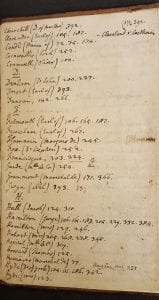 “Another runner-up to Tonton’s snuff-box is Walpole’s copy of Gramont’s Mémoires, 1746, the copy he used when editing and printing the Strawberry Grammont in 1772. He made an index for this copy and added notes throughout it, all of which he used in the Strawberry edition, his copy of which is also at Farmington, annotated and extra-illustrated by him. He dedicated it ‘A Madame__________. L’Editeur vous consacre cette Edition, comme un monument de son Amitié, de son Admiration, & de son Respect; à Vous, dont les Graces, l’Esprit, & le Goût retracent au siecle present le siecle d Louis quatorze & les agrements de l’Auteur de ces Memoires.’ In his copy he wrote Mme du Deffand’s name after the bland her modesty insisted upon and added two charming little engravings; the upper one of three putti crowning a book with laurel, the lower of a monument embowered with flowering shrubs. No collector ever enjoyed adorning his books more than Walpole. Of the hundred copies he printed of the Grammont, twelve are at Farmington; they include presentation copies to the Duchess of Bedford, Lord Nuneham, George Montagu, Mrs Damer, and Richard Bull, who extra-illustrated his copy lavishly, as usual.
“Another runner-up to Tonton’s snuff-box is Walpole’s copy of Gramont’s Mémoires, 1746, the copy he used when editing and printing the Strawberry Grammont in 1772. He made an index for this copy and added notes throughout it, all of which he used in the Strawberry edition, his copy of which is also at Farmington, annotated and extra-illustrated by him. He dedicated it ‘A Madame__________. L’Editeur vous consacre cette Edition, comme un monument de son Amitié, de son Admiration, & de son Respect; à Vous, dont les Graces, l’Esprit, & le Goût retracent au siecle present le siecle d Louis quatorze & les agrements de l’Auteur de ces Memoires.’ In his copy he wrote Mme du Deffand’s name after the bland her modesty insisted upon and added two charming little engravings; the upper one of three putti crowning a book with laurel, the lower of a monument embowered with flowering shrubs. No collector ever enjoyed adorning his books more than Walpole. Of the hundred copies he printed of the Grammont, twelve are at Farmington; they include presentation copies to the Duchess of Bedford, Lord Nuneham, George Montagu, Mrs Damer, and Richard Bull, who extra-illustrated his copy lavishly, as usual.
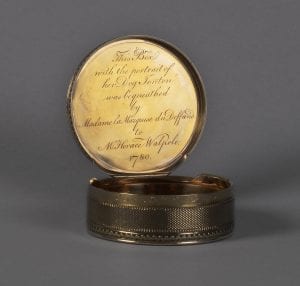 “The single object at Farmington that brings the two friends most strongly together is not the dedication copy of the Grammont or ‘Recueil de divers ouvrages,’ but the very beautiful circular gold snuff-box made by Roucel, the king’s jeweler, that give us Tonton in his plump latter days sitting on a cushion with his right front paw uplifted appealingly. Inside the lid, his master had inscribed, ‘This box with the portrait of her dog Tonton was bequeathed by Madame la Marquise du Deffand to Mr Horace Walpole, 1780.’ but before I talk about Tonton I should speak of his predecessors.
“The single object at Farmington that brings the two friends most strongly together is not the dedication copy of the Grammont or ‘Recueil de divers ouvrages,’ but the very beautiful circular gold snuff-box made by Roucel, the king’s jeweler, that give us Tonton in his plump latter days sitting on a cushion with his right front paw uplifted appealingly. Inside the lid, his master had inscribed, ‘This box with the portrait of her dog Tonton was bequeathed by Madame la Marquise du Deffand to Mr Horace Walpole, 1780.’ but before I talk about Tonton I should speak of his predecessors.
Lewis then lists Walpole’s dogs before Tonton in order of acquisition and includes an anecdote about each: Tory, the King Charles spaniel who was dragged off by a wolf in the Alps; Patapan, the small white spaniel who featured in the title of Walpole’s work Patapan or the Little White Dog, a Tale imitated from Fontaine; and Rosette, a black and tan spaniel “Walpole believed saved his life by warning him of a chimney fire. . . .”
“Mme du Deffand’s first of 69 references to Tonton was when he, aged four months, was sitting on her shoulder while she dictated her letter. A year later she asked Walpole, even before Walpole had seen him, to take him after her death. Tonton was very pretty, she said, and Walpole would love him, but she did not add that he wasn’t house-broken and bit people. Thomas Walpole proved his friendship by bringing Tonton to England when his mistress died, a kindness that must have added much to the hardship of those four exhausting days of travel. Walpole doted on Tonton. ‘You will find that I have gotten a new idol,’ he wrote Mason, ‘in a word, a successor to Rosette and almost as great a favourite, nor is this a breach of vows and constancy, but an act of piety. In a word, my poor dear old friend Madam du Deffand had a little dog of which she was extremely fond, and the last time I saw her she made me promise if I should survive her to take charge of it. I did. It is arrived and I was going to say, it is incredible how fond I am of it, but I have no occasion to brag of my dogmanity. I dined at Richmond House t’other day, and mentioning whither I was going the Duke said, “Own the truth, shall not you call at home first and see Tonton?” He guessed rightly. He is now sitting on my paper as I write–not the Duke but Tonton.’
“At just this time Walpole wrote in his pocket notebook mentioned in Choice 4.
“‘Charade on my dog Tonton
The first part is thine, the second belongs only to the people of fashion; but the whole, tho doubly thine, belongs only to me.’
“When Tonton died Walpole wrote Lady Ossory that his death was merciful, for
“‘He was grown stone deaf, and very near equally blind, and so weak that the two last days he could not walk upstairs. Happily he had not suffered, and died close by my side without a pang or a groan. I have had the satisfaction for my dear old friend’s sake and his own,of having nursed him up by constant attention to the age of sixteen, yet always afraid of his surviving me, as it was scarce possible he could meet a third person who would study his happiness equally. I sent him to Strawberry and went thither on Sunday to see him buried behind the Chapel near Rosette.'”
Lewis, Wilmarth S. Rescuing Horace Walpole. New Haven and London: Yale University Press, 1978.
To see the full chapter from Rescuing Horace Walpole called “ 26. Choice 16: Tonton’s Snuff-Box” download or expand the link here:
 Loading...
Loading...
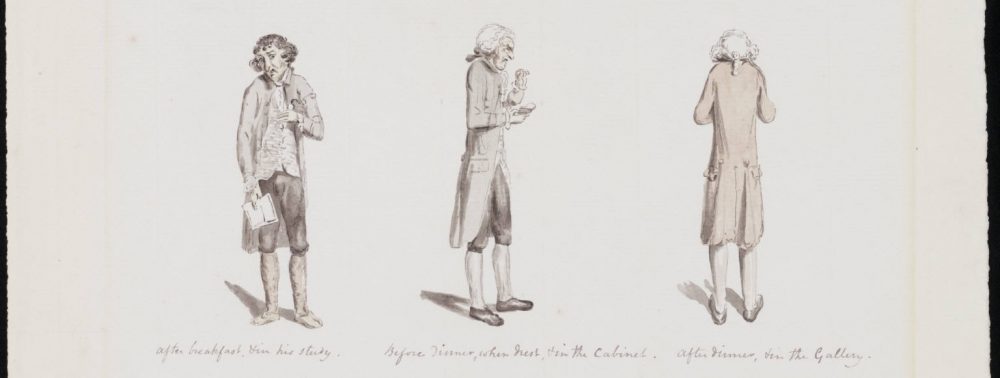


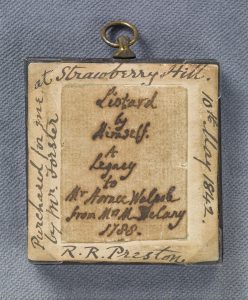
![The Cabinet of Miniatures and Enamels [John Carter] (in Folio 33 30 copy 11)](https://campuspress.yale.edu/walpole300/files/2017/09/lwlpr15618-rggmjt-231x300.jpg)
